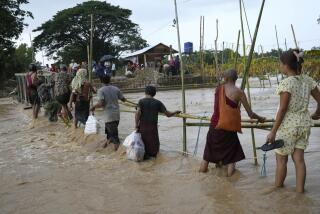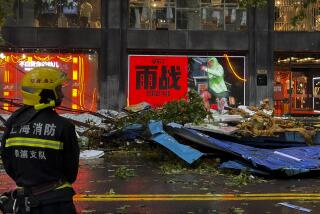Filipinos start over in city wiped out by typhoon

TACLOBAN, Philippines — Rising from a sea of debris, the small, rickety shell of a new house already was beginning to take shape.
Rolito Solayao worked swiftly Monday, using pieces of wood and nails scavenged from the wreckage of this coastal city. His wife swept dirt from the concrete floor, the only part of their home that survived when Typhoon Haiyan tore through the central Philippines on Nov. 8.
Asked her name, she let out a weary laugh: Yolanda, the name Filipinos gave to the storm.
More than a week after one of the most powerful storms on record, there are signs that life is returning to what just days ago was described by traumatized residents as a dead city.
The sound of hammering reverberates through flattened neighborhoods. Small stands have appeared in front of shuttered stores, offering bottles of soda, dried fish and bananas. Some gas stations have opened, bringing motorcycles and cars back to the streets. Piped water and cellphone communications have been partially restored. And international relief efforts are ramping up.
But even in a country long used to natural disasters, the scale of the devastation is staggering. Life will be very different now. Virtually every building in Tacloban was damaged or destroyed. Great piles of broken wood, metal sheeting and upended vehicles block many streets. Laundry hangs from downed power lines void of electricity, and families sleep under makeshift tents amid the ruins of their homes.
Wafting from beneath the rubble, the stench of trapped and unclaimed bodies is at times overpowering.
Yolanda Solayao is still looking for her mother and sister. They refused to leave the family home when Solayao evacuated with her husband and seven children to San Jose Central School.
“If we find them, they will already be dead,” said Solayao, who was still in the clothes she was wearing the morning of the typhoon.
Their neighborhood is on a narrow peninsula in southeast Tacloban and was buffeted by storm surges from two directions. Even the evacuation center flooded, sending panicked residents scrambling to the second floor, Solayao said.
When the water subsided, their home, and most of the neighborhood, was gone.
The family would move if they could, Solayao said. But they don’t have the means, or relatives who can help. The fact that she shared a name with the storm only adds to the hurt.
“I can never forget this tragedy,” she said.
In all, between 10 million and 12.9 million people were affected when the storm hit the island nation in the Western Pacific, according to the latest government and United Nations estimates. They include at least 3,976 killed, 1,598 missing and 4 million displaced.
Most of the casualties were on the islands of Leyte and Samar, which were hit by the massive storm surges. The city of Tacloban, the Leyte provincial capital, was the worst-hit.
Although the 2004 tsunami in the Indian Ocean affected a much wider geographic area, the impact on individual cities such as Tacloban is comparable, said Ben Hemingway, a regional advisor with the Office of U.S. Foreign Disaster Assistance at the U.S. Agency for International Development.
“One is tempted to despair,” President Benigno Aquino III told reporters Monday as he toured hard-hit rural communities near Tacloban that are just beginning to receive attention.
Under fire for what critics describe as a slow response to the disaster, Aquino announced over the weekend that he would stay in the city for a while to oversee the relief efforts.
Though he praised the response of some local authorities, he questioned why other places had borne the brunt of the casualties, suggesting that they might not have done a good job preparing for the storm or responding once it hit.
Tacloban’s mayor, Alfred Romualdez, told the BBC that the city’s first responders were “victims too” and that the city was “on its knees.” Many city employees are only beginning to report for duty; others remain unaccounted for.
In the seafront neighborhood of San Fernando Magallanes, an elderly woman covered her nose with a scarf as she gingerly made her way across a field of debris covering several blocks and rising more than 3 feet high. A child’s muddy teddy bear rested amid the rubble, along with other remnants of a once-vibrant community of fishermen, shopkeepers and government workers.
Residents said many people decided not to heed the government’s advice to evacuate.
“The only news I had is that a typhoon was coming, not a tidal wave,” explained Maximo Roa Jr., who used to drive a delivery van. “We are used to typhoons.”
In fact, relatives came to his house to ride out the storm because they were afraid of mudslides in their area. When the surge hit, the family waded through chest-high water to shelter at a neighbor’s two-story home.
It took Roa’s wife, Analiza, more than a week to scrub all the mud out of their home and clothing. He managed to salvage some metal sheeting to repair the roof, but had to weigh it down with sandbags because he couldn’t find any nails.
This weekend the couple collected their first aid package, which included rice, noodles and sardines. They say their children keep asking when they will leave. But as long as there is food and security, they are hopeful that the city will eventually recover.
“This is my home,” Roa said. “This is where I grew up. This is where my mother grew up.”
Around the corner at San Fernando Central School, the future appeared dark to Brigitte Trinidad, who has worked as a singer, dance instructor and city office worker.
For Trinidad, “home” is now a green plastic bench on the school veranda. Inside the classrooms, scores of displaced families have carved out living spaces by stringing up sheets and building walls out of salvaged furniture.
Before the storm hit, Trinidad evacuated her two children to the school. But she thought she could remain safe in her house with her boyfriend because it was made of concrete.
Instead, a giant wave crashed through a wall and washed them away. Seconds later, she said, the house collapsed. The pair grabbed hold of the skeleton of another house and held on for dear life. Debris carried by the raging floodwaters cut their arms and legs.
When they thought they couldn’t hang on any longer, the water subsided enough for their feet to touch the ground. They climbed over a neighbor’s wall and took refuge on his roof.
Trinidad said she doesn’t sleep well anymore. There is no privacy at the school, and she just lies awake, worrying.
“We are thankful we survived, but how will we stand again?” she asked. “We are just only waiting for help.”
The government and international relief agencies are discussing plans to put up tents so schools like this one can be cleared out for classes to resume. There is also talk of cash-for-work programs to help get the economy going. But officials say it will take months, if not years, for the city to get back on its feet.
Although access in the city has improved with the clearing of the main roads, government work crews, hampered by shortages of equipment and personnel, haven’t started on the side streets. Residents are banding together in some areas to haul away debris and burn it.
Few stores are open. The storm wiped most of them out, and the owners say they are afraid they will be looted if they invest in new stock and infrastructure.
Michelle Mataro spent her day Sunday waiting in one long distribution line after another. Her house was mostly destroyed, so she is sleeping in a minibus that came to rest nearby.
She picked up two large bottles of water at one site, but there was no food on offer, she said. Another site was handing out blankets, sleeping mats and mosquito nets. She said she waited two hours in that line only to be told that supplies had run out.
“That’s how we live our life now,” she said as she hurried off in the rain.
More to Read
Sign up for Essential California
The most important California stories and recommendations in your inbox every morning.
You may occasionally receive promotional content from the Los Angeles Times.








